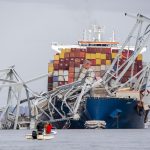The massive cargo ship crash into Baltimore’s Francis Scott Key Bridge in Baltimore will likely lead to billions of dollars in liability claims. Marine insurance companies will be on the hook for much of the costs.
With various owners and companies involved – and with some maritime laws predating even the Titanic sinking – untangling the web, figuring out who owes what, and addressing the damages from both lives lost and to physical structures will be complex.
“This claim has the potential to be north of a billion dollars,” said John Miklus, the president of the American Institute of Marine Underwriters. “Litigation will run years.”
The Dali ship is owned by Grace Ocean Private, a Singapore-based company, and insured by the Britannia Protection and Indemnity Club.
Britannia is one of the dozen marine insurance member clubs under the International Group of P&I Clubs, a consortium that provides marine liability coverage for 90% of ocean freight and pools liability claims among members. (The International Group of P&I Clubs did not respond to CNN’s request for comment.)
These insurance companies are backed by insurance companies of their own – a type of business known as a reinsurer.
Around 80 different reinsurers provide around $3 billion in coverage to the Dali’s insurers, according to Moody’s analyst Brendan Holmes. Since the losses will be spread across so many insurers, it’s unlikely to bankrupt any of the companies or cause a major bump in insurance prices, he said.
Miklus told CNN that these P&I insurance clubs collectively pool losses, but they also buy “an extensive reinsurance program.”
“So, when we start talking about losses of a billion or more, this is being spread through the whole global reinsurance market,” Miklus added.
It’s still too early to know the final bill for damages and rebuilding.
The bridge alone could be worth more than $1.2 billion, said Loretta Worters, a spokesperson for the Insurance Information Institute. Then there will almost certainly be large liability suits, medical costs for survivors, clean-up costs, and more, she added.
Damage and losses to cars and clean-up from the debris and reconstruction will also factor into the total, Worters said.
Miklus cited the roughly $1.5 billion insurance payout after the Costa Concordia cruise ship was grounded on an island off Italy in 2012 as one of the highest insurance claims in recent memory. “I would expect this one would rival that kind of claim in terms of total cost,” he said.
Bloomberg reported that insurers face claims of as much as $3 billion, citing a note from Barclays analysts. Barclays declined to comment to CNN.
While Dali is owned by Grace Ocean Private, it was chartered by Danish shipping giant Maersk when it plowed into the bridge early Tuesday morning.
When it comes to maritime law, “all the liability ends up with the ship owner, which will be the Singaporean company,” said Martin Davies, the director of the Maritime Law Center at Tulane University. “Maersk, the Danish company that has all the cargo on board the vessel, is not liable,” Davies added.
But the ship owner has the potential to significantly cap how much it is liable for in this case, thanks to a statute that dates back to 1851.
The statute – which was used by the owners of the RMS Titanic, among other instances – could limit the ship owner’s liability to how much the Dali was worth after it crashed.
Of course, the bridge will almost certainly get rebuilt, no matter how much insurance is paid out. President Joe Biden on Tuesday said the federal government will pay for the cost of rebuilding the Francis Scott Key Bridge, though it’s not immediately clear where that money would come from or how much that endeavor would cost.
“It’s my intention that the federal government will pay the entire cost of reconstructing that bridge,” Biden said Tuesday. “And I expect the Congress to support my effort,” he said, adding that the process will “take some time.”
The president’s comments notably come amid his re-election campaign. Some funding could come from the Federal Highway Administration, as well as the Infrastructure Investment and Jobs Act passed under Biden that provides grants to improves the nation’s bridges. But it could also require additional funding from Congress.
While the ship’s collision with the bridge is likely to interrupt businesses in the area, Davies notes that purely economic losses are not recoverable from the ship’s owners in a maritime tort claim.
“All the business interruption losses, which will be significant, will not be recoverable from the ship,” Davies said, citing a 1927 Supreme Court decision, Robins Dry Dock and Repair Co. v. Flint, which he says set that precedent.
“For example, I believe there’s a Domino sugar refinery right next to the bridge that uses it all the time, and it will suffer significant economic losses as a result that are not recoverable,” Davies said.
But claims from people who lost family members or who were injured in the collapse are likelier to succeed.
“But other than that, the economic impact of what has happened will be enormous, but not recoverable from the ship,” Davies said.
Maryland lawmakers, meanwhile, are drafting an emergency bill to provide income replacement for Port of Baltimore workers impacted by the bridge collapse. “The human cost of lives lost yesterday is overwhelming and tragic,” Maryland State Senator Bill Ferguson said in a post on X. “The economic and stability loss to the thousands impacted in the days ahead cannot be understated.”
Read the full article here




